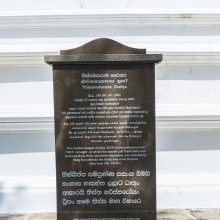Kimu, Kim-u: 7 definitions
Introduction:
Kimu means something in Hinduism, Sanskrit, Jainism, Prakrit, biology. If you want to know the exact meaning, history, etymology or English translation of this term then check out the descriptions on this page. Add your comment or reference to a book if you want to contribute to this summary article.
Images (photo gallery)
Biology (plants and animals)
Source: Google Books: CRC World Dictionary (Regional names)1) Kimu in Nepal is the name of a plant defined with Morus australis in various botanical sources. This page contains potential references in Ayurveda, modern medicine, and other folk traditions or local practices It has the synonym Morus nigriformis Koidz. (among others).
2) Kimu is also identified with Morus macroura It has the synonym Morus wittiorum Hand.-Mazz. var. mawu Koidz. (etc.).
Example references for further research on medicinal uses or toxicity (see latin names for full list):
· Notes from the Royal Botanic Garden, Edinburgh (1912)
· Notulae ad Plantas Asiaticas (1854)
· Plantae Junghuhnianae (1851)
· Acta Phytotaxonomica Sinica (1991)
· FBI (1888)
· Encyclopédie Méthodique, Botanique (Lamarck) (1797)
If you are looking for specific details regarding Kimu, for example extract dosage, diet and recipes, chemical composition, pregnancy safety, health benefits, side effects, have a look at these references.

This sections includes definitions from the five kingdoms of living things: Animals, Plants, Fungi, Protists and Monera. It will include both the official binomial nomenclature (scientific names usually in Latin) as well as regional spellings and variants.
Languages of India and abroad
Sanskrit dictionary
Source: DDSA: The practical Sanskrit-English dictionaryKimu (किमु).—
1) whether-or (showing doubt or uncertainty); किमु विष- विसर्पः किमु मदः (kimu viṣa- visarpaḥ kimu madaḥ) Uttararāmacarita 1.35; Amaruśataka 12.
2) why (indeed) कं च ते परमं कामं करोमि किमु हर्षितः (kaṃ ca te paramaṃ kāmaṃ karomi kimu harṣitaḥ) Rām.1.18.52. प्रियसुहृ- त्सार्थः किमु त्यज्यते (priyasuhṛ- tsārthaḥ kimu tyajyate).
3) how much more, how much less; यौवनं धनसंपत्तिः प्रभुत्वमविवेकिता । एकैकम यनर्थाय किमु यत्र चतुष्टयम् (yauvanaṃ dhanasaṃpattiḥ prabhutvamavivekitā | ekaikama yanarthāya kimu yatra catuṣṭayam) || .II Pr.11; सर्वाविनयानामेकैकमप्येषामायतनं किमुत समवायः (sarvāvinayānāmekaikamapyeṣāmāyatanaṃ kimuta samavāyaḥ) K.13; R.14.35; Kumārasambhava 7.65.
Kimu is a Sanskrit compound consisting of the terms kim and u (उ). See also (synonyms): kimuta.
Source: Cologne Digital Sanskrit Dictionaries: Shabda-Sagara Sanskrit-English DictionaryKimu (किमु).—ind. Either, or, whether implying doubt or discrimination: see kim.
Source: Cologne Digital Sanskrit Dictionaries: Yates Sanskrit-English DictionaryKimu (किमु):—conj. Either or whether.
Source: DDSA: Paia-sadda-mahannavo; a comprehensive Prakrit Hindi dictionary (S)Kimu (किमु) in the Sanskrit language is related to the Prakrit word: Kimu.
Sanskrit, also spelled संस्कृतम् (saṃskṛtam), is an ancient language of India commonly seen as the grandmother of the Indo-European language family (even English!). Closely allied with Prakrit and Pali, Sanskrit is more exhaustive in both grammar and terms and has the most extensive collection of literature in the world, greatly surpassing its sister-languages Greek and Latin.
Prakrit-English dictionary
Source: DDSA: Paia-sadda-mahannavo; a comprehensive Prakrit Hindi dictionaryKimu (किमु) in the Prakrit language is related to the Sanskrit word: Kimu.
Prakrit is an ancient language closely associated with both Pali and Sanskrit. Jain literature is often composed in this language or sub-dialects, such as the Agamas and their commentaries which are written in Ardhamagadhi and Maharashtri Prakrit. The earliest extant texts can be dated to as early as the 4th century BCE although core portions might be older.
Kannada-English dictionary
Source: Alar: Kannada-English corpusKīmu (ಕೀಮು):—[noun] a thick opaque usu. yellowish white fluid matter formed by suppuration and composed of exudate containing white blood cells, tissue debris, and micro organisms; pus.
Kannada is a Dravidian language (as opposed to the Indo-European language family) mainly spoken in the southwestern region of India.
See also (Relevant definitions)
Starts with: Kimuga, Kimuk, Kimuka, Kimul, Kimulcu, Kimulikwi kidala, Kimulikwi-jike, Kimuta, Kimutsedha, Kimuu, Kimuya.
Ends with: Athakimu, Chainauaukimu.
Full-text (+35): Athakimu, U, Kimuta, Kim, Atha, Kutukita, Shrotrata, Visarpa, Nishatti, Anavadya, Dhanayati, Rudhasauhrida, Duranta, Gatabhartrika, Kekin, Kekika, Kekavala, Sauhardya, Sauhrida, Sauhridya.
Relevant text
Search found 33 books and stories containing Kimu, Kim-u, Kīmu; (plurals include: Kimus, us, Kīmus). You can also click to the full overview containing English textual excerpts. Below are direct links for the most relevant articles:
Sahitya-kaumudi by Baladeva Vidyabhushana (by Gaurapada Dāsa)
Text 10.42 < [Chapter 10 - Ornaments of Meaning]
Text 8.13 < [Chapter 8 - Literary Qualities]
Text 11.20 < [Chapter 11 - Additional Ornaments]
Satapatha-brahmana (by Julius Eggeling)
Kāṇḍa IV, adhyāya 6, brāhmaṇa 5 < [Fourth Kāṇḍa]
Vivekachudamani (by Shankara)
Hanuman Nataka (critical study) (by Nurima Yeasmin)
10. Supernatural Elements < [Chapter 4]
7. Information of Various Flora and Fauna < [Chapter 5]
Sanskrit sources of Kerala history (by Suma Parappattoli)
4. The Mayura-sandesa by Udaya < [Chapter 4 - Traces of Historical Facts from Sandesha Kavyas and Short poems]
Shishupala-vadha (Study) (by Shila Chakraborty)
Knowledge of Tantra in the Śiśupālavadha < [Introduction]
Amātya according to Manu < [Chapter 2b - Activities of Minister (Amātya)]
The influence of Kālidāsa, Bhāravi and Bhaṭṭi on the Śiśupālavadha < [Introduction]
